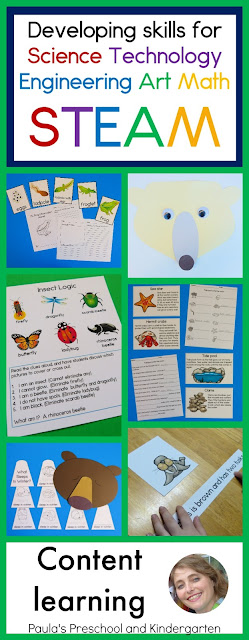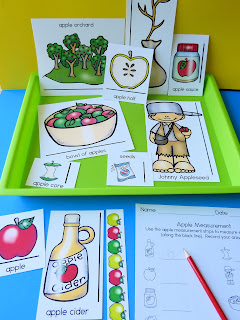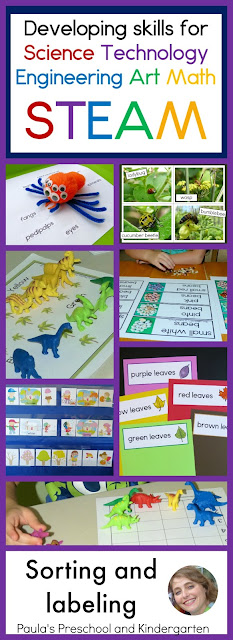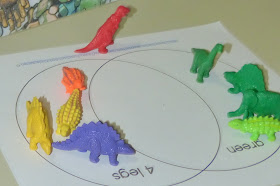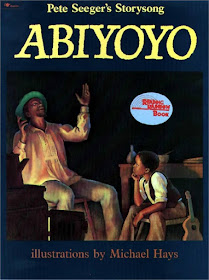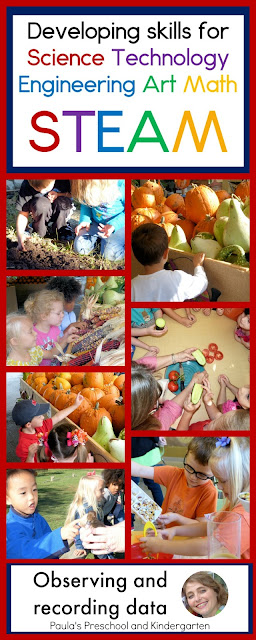Can you hear the music? Do you want to continue the song / text? "Hat berry, shoe berry, in my canoe berry."
Need another hint? This one is by Bruce Degen - it's Jamberry, of course! To hear the song, check out this youtube video.
I love teaching and learning with young children, this is where I share my ideas.
Pages
▼
Monday, December 11, 2017
Monday, December 4, 2017
Can you name this children's book?
Surely you've read this book with your primary grade students - it's The Legend of the Poinsettia, by Tomie dePaola. I've read it during the holiday season for many years, and like to do this beautiful craft project to go along with it! Wishing you a joyous holiday season!
Sunday, November 19, 2017
Wishing you a Beauti-Fall Thanksgiving Week
There are so many things that I am thankful for.
My family. My dogs (who ARE family). Work that I love doing, and people I enjoy doing it with. Home. Friends near and far. Small children and the joy they bring to everything. Abundance, and beautiful places to enjoy it. I could go on, but two doggies and this view are waiting for me, and if we are to be truly grateful, we have to go and immerse ourselves in life, and soak it all up.
Wishing you blessings beyond measure this holiday season!
Paula
My family. My dogs (who ARE family). Work that I love doing, and people I enjoy doing it with. Home. Friends near and far. Small children and the joy they bring to everything. Abundance, and beautiful places to enjoy it. I could go on, but two doggies and this view are waiting for me, and if we are to be truly grateful, we have to go and immerse ourselves in life, and soak it all up.
Wishing you blessings beyond measure this holiday season!
Paula
Monday, November 13, 2017
Can You Name This Children's Book?
Last week's Can You Name This Children's Book was a bit tricky, so this week I'm making it - I think - much easier. Using the picture and the quote below it, can you figure it out?
If you said Eric Carle's The Very Hungry Caterpillar, you're right! I think almost everyone has read this one, and it's actually one of my earliest book memories - Mrs. Potts read it to me waaaaay back when I was in first grade.
To be notified when I make new posts, follow my blog or my FaceBook page!
If you said Eric Carle's The Very Hungry Caterpillar, you're right! I think almost everyone has read this one, and it's actually one of my earliest book memories - Mrs. Potts read it to me waaaaay back when I was in first grade.
To be notified when I make new posts, follow my blog or my FaceBook page!
Sunday, November 12, 2017
STEAM (Science, Technology, Engineering, Art and Math) skills: learning the content
Are you old enough to remember the short films schools used to show when teaching science content? I am. They were usually old, grainy, black and white films (and I mean film, on film strips, presented on a noisy film projector), but the worst thing about them was how incredibly boring they were. That kind of teaching just didn't inspire a whole lot of learning!
There are so many other, more exciting ways to present content information, and to help our students learn the facts they need to know. Today I'm going to show you some of my favorites.
My students love to observe and explore, so I have always included real animals in my classrooms. My first year teaching I had a fish tank (good plan), raised caterpillars (good plan), had plants in the classroom (good plan), and raised two ducklings (NOT a good plan - they poop a LOT, smell, and need fresh water a couple of times a day). Since then we've also had tadpoles and frogs, earth worms, various insects, herb, vegetable and flower gardens, a hamster, and an outside area full of possibilities. Children (and adults) find nature fascinating, and can learn a tremendous amount from observing the plants and animals in our world. Why not provide a way for them to record what they see?
Of course, some things are best learned about at a safe distance (sharks and piranhas for example), or are inaccessible. When we use awesome pictures and information presented at an age appropriate level, factual content can be fascinating and engaging. To make it easier to find just the right text, most of my guided reading books include texts at multiple levels.
Read and write the room activities can include non-fiction learning...
... and so can logic puzzles....
... and simple sentence picture match activities!
If you've been reading this series about STEAM learning, you know I also like to make thematic resources, to incorporate science, technology, engineering, art and math. I love it when everything I need is together, ready to go.
There are so many other, more exciting ways to present content information, and to help our students learn the facts they need to know. Today I'm going to show you some of my favorites.
My students love to observe and explore, so I have always included real animals in my classrooms. My first year teaching I had a fish tank (good plan), raised caterpillars (good plan), had plants in the classroom (good plan), and raised two ducklings (NOT a good plan - they poop a LOT, smell, and need fresh water a couple of times a day). Since then we've also had tadpoles and frogs, earth worms, various insects, herb, vegetable and flower gardens, a hamster, and an outside area full of possibilities. Children (and adults) find nature fascinating, and can learn a tremendous amount from observing the plants and animals in our world. Why not provide a way for them to record what they see?
Of course, some things are best learned about at a safe distance (sharks and piranhas for example), or are inaccessible. When we use awesome pictures and information presented at an age appropriate level, factual content can be fascinating and engaging. To make it easier to find just the right text, most of my guided reading books include texts at multiple levels.
Solution #2: non-fiction guided reading texts
Even emergent readers want to learn about the world around them, so it's important to find non-fiction texts they can master.
Solution #3: informational craftivities
Solution #4: read and write the room
... and so can logic puzzles....
Solution #5: Non-fiction logic puzzles
... and simple sentence picture match activities!
Solution #6: sentence picture match
What are your favorite ways to make learning content engaging? Is there a subject you wish you could find this kind of resources for? (I'm always looking for ideas of resources to create!) Let me know in the comments!
Monday, November 6, 2017
Can You Name This Children's Book? (#4)
When you look at this picture, does a particular children's book come to mind? How about if you read the quote too: "If you go down to the woods today, you're sure of a big surprise" ?
I remember hearing this recording of it waaaay back when (it came out in 1977)! It's Teddy Bears' Picnic of course!
If you enjoyed this little guessing game, I'm posting a new "Can you name this children's book" each week - I'd love you to follow my blog and play along with me! Have an awesome day!
I remember hearing this recording of it waaaay back when (it came out in 1977)! It's Teddy Bears' Picnic of course!
If you enjoyed this little guessing game, I'm posting a new "Can you name this children's book" each week - I'd love you to follow my blog and play along with me! Have an awesome day!
Saturday, November 4, 2017
STEAM skills (Science, Technology, Engineering, Art & Math) - measurement and graphing
Welcome to part 3 of my STEAM skills series! If you haven't already seen them, here are links to part 1 and part 2. If you've been reading along, you've probably already figured out how much fun I have incorporating STEAM into my teaching!
Today I'm going to focus on measurement and graphing - they're important skills for science, math, and engineering, and they're super easy to add to your day to day classroom life.
There are lots of ways to include measurement, because there are so many things to measure! It's developmentally appropriate for young children to measure with non-standard units, that is, they don't need to use inches, centimeters, pounds or kilograms. For young children measurement should involve how many _____ long something is, filling and counting scoops, or how many _____ something weighs.
One of my favorite ways to measure with children is to cook: they can measure and count how many cups or teaspoons of each ingredient, weigh things, and of course, there's the fun of eating the finished product! (Look at the concentration on these little faces, and look how they're also developing hand strength and pouring skills as they make a birthday cake.)
You can measure with real objects - like pumpkin candies, paper clips, or toy blocks, or you can use a measurement tool with pictures of objects.
Measurement can also be a matter of comparing: longer or shorter, heavier or lighter. We wondered which of our vegetables was heavier than a glue bottle - and then checked to find out.
Children like to measure themselves too of course, so we laid on the floor, cut ribbon to the length of each child, and then made a cute display to show our heights.
There are so many ways to measure - but what about graphing? Isn't that more challenging? I don't find it to be! If you have a full day school program, you likely already graph daily to see who brought lunch, and who needs a cafeteria meal - our cafeteria needed that information each morning to help them prep, so the children moved their name to the correct side of the lunch count graph each morning. There's so many more things you can graph though!
How about which day each child brought something to school?
You'll notice the children's names are on this one with sticky notes - so I can use this graph time and again. Children can graph with math manipulatives...
...or by stamping or coloring a space on a paper...
or in a pocket chart!
If you need help coming up with graphing activities, check out these resources in my TeachersPayTeachers store - including 3 FREE resources! Some of the other photos included in this blog are of resources I've created, you can also click on those to see more.
I hope you've found some new ideas in this blog post, and that you'll come back next week to continue this STEAM skill series! Happy Teaching!
Paula
Today I'm going to focus on measurement and graphing - they're important skills for science, math, and engineering, and they're super easy to add to your day to day classroom life.
There are lots of ways to include measurement, because there are so many things to measure! It's developmentally appropriate for young children to measure with non-standard units, that is, they don't need to use inches, centimeters, pounds or kilograms. For young children measurement should involve how many _____ long something is, filling and counting scoops, or how many _____ something weighs.
One of my favorite ways to measure with children is to cook: they can measure and count how many cups or teaspoons of each ingredient, weigh things, and of course, there's the fun of eating the finished product! (Look at the concentration on these little faces, and look how they're also developing hand strength and pouring skills as they make a birthday cake.)
You can measure with real objects - like pumpkin candies, paper clips, or toy blocks, or you can use a measurement tool with pictures of objects.
Measurement can also be a matter of comparing: longer or shorter, heavier or lighter. We wondered which of our vegetables was heavier than a glue bottle - and then checked to find out.
Children like to measure themselves too of course, so we laid on the floor, cut ribbon to the length of each child, and then made a cute display to show our heights.
How about which day each child brought something to school?
You'll notice the children's names are on this one with sticky notes - so I can use this graph time and again. Children can graph with math manipulatives...
...or by stamping or coloring a space on a paper...
or in a pocket chart!
If you need help coming up with graphing activities, check out these resources in my TeachersPayTeachers store - including 3 FREE resources! Some of the other photos included in this blog are of resources I've created, you can also click on those to see more.
I hope you've found some new ideas in this blog post, and that you'll come back next week to continue this STEAM skill series! Happy Teaching!
Paula
Monday, October 30, 2017
Can You Name This Children's Book (#3)
This is one of my absolute favorite Halloween stories! I memorized this book by listening to the book on cassette tape (that gives you a clue to how old the book is!), and it has always been a huge hit with my first graders, then my own children, preschoolers and kindergarteners. Do you know what it is? Big Pumpkin, by Erica Silverman! To see if you can name more children's books from clues like this one, click here! To hear Big Pumpkin on YouTube, click here.
Happy Halloween everyone!
Happy Halloween everyone!
Monday, October 23, 2017
More easy steps for amazing STEAM learning
Recently I began a blog post series about STEAM learning (STEAM stands for Science, Technology, Engineering, Art and Math) by looking at some ways to practice observing and recording data - 2 of the most basic science skills. Today I want to continue with sorting, classifying, and labeling.
My students have always loved sorting / classifying. Whether it's sorting building blocks by color, finding all the big buttons in my button box, or separating the mini erasers by shape, sorting seems to be a basic part of coming to understand their world. Why not encourage it with fun materials, and add labels to those categories?!
It's easy to take sorting a step further with Venn Diagrams - which make us consider more than one sort-able attribute at a time. Do you see the red t-rex in this picture? It isn't green, and doesn't walk on 4 legs, so the child asked me where it should go. I helped him think it through - can it go in the green circle? No. Can it go in the 4 legs circle? No. Is there a place on your sorting mat that isn't for green and isn't for 4 legs? Children can do some amazing thinking!
Once children have begun categorizing things - not just sorting them, but also identifying how they've sorted them, it's a natural progression to count those things, and to compare what has more or less. Graphs make it easy to compare several categories. (More on graphs next time!)
Children can also begin to label things they observe, from a single word for each item...
... to details as they develop vocabulary.
Don't you love teaching STEAM skills?!
My students have always loved sorting / classifying. Whether it's sorting building blocks by color, finding all the big buttons in my button box, or separating the mini erasers by shape, sorting seems to be a basic part of coming to understand their world. Why not encourage it with fun materials, and add labels to those categories?!
It's easy to take sorting a step further with Venn Diagrams - which make us consider more than one sort-able attribute at a time. Do you see the red t-rex in this picture? It isn't green, and doesn't walk on 4 legs, so the child asked me where it should go. I helped him think it through - can it go in the green circle? No. Can it go in the 4 legs circle? No. Is there a place on your sorting mat that isn't for green and isn't for 4 legs? Children can do some amazing thinking!
Once children have begun categorizing things - not just sorting them, but also identifying how they've sorted them, it's a natural progression to count those things, and to compare what has more or less. Graphs make it easy to compare several categories. (More on graphs next time!)
Children can also begin to label things they observe, from a single word for each item...
... to details as they develop vocabulary.
Sunday, October 22, 2017
Can You Name This Children's Book? (episode 2)
"But if you want to visit my tree, come in the fall. That's my favorite time. Can you guess why?"
It's Red Leaf, Yellow Leaf, by Lois Ehlert. I love it - do you?
Thursday, October 19, 2017
Can You Name This Children's Book?
Do you ever see something, and immediately connect it to a children's book, or perhaps a song? It happens to me all the time! Last week I saw this:
...and into my head popped, "One day, one day, the sun rose blood red in the sky..."
Can you name the children's book the line is from? Scroll down for the answer!
If you'd like to see the Reading Rainbow version of the book, click here! The version I had on cassette tape (in the olden days, obviously!) was read by James Earl Jones. I've looked for it, but can't find a link to that version - if anyone has it, please let me know in the comments!
Can you name the children's book the line is from? Scroll down for the answer!
If you'd like to see the Reading Rainbow version of the book, click here! The version I had on cassette tape (in the olden days, obviously!) was read by James Earl Jones. I've looked for it, but can't find a link to that version - if anyone has it, please let me know in the comments!
Sunday, October 15, 2017
Sunday, October 8, 2017
Surprisingly easy ways to teach STEAM skills in early childhood (STEAM learning, post #1)
One of the hot teaching buzz words now is STEAM learning: Science, Technology, Engineering, Art and Math, and incorporating skills for them throughout our curriculum. Are they important? Yes! Can you do it without thinking about it? Probably not. Is it going to be hard to include them? NO!
In this blog series, I want to take a look at some STEAM skills, and show you some of the ways I like to incorporate them. I hope you find a few new ideas! Today I want to write about two of the very first, most basic skills:
Observing and Recording
If you've ever spent time around a child, you know children need to observe and explore everything. They want to dig in the dirt, find small critters, see what is inside a tomato, feel how bumpy a pumpkin is, taste the honeysuckle, and roll themselves down a hill. This is science - exploring, investigating and observing everything.
Recording data can be challenging with young children, especially in preschool, before they learn to write. Photographs are one of my favorite ways to record young children's learning! Every one of the photos in the collage above went into my students' school photo albums - and provided opportunities to revisit and discuss the hands on experiences we enjoyed.
As children develop their fine motor skills, and begin to write and draw, more options for recording data become available. They can draw...
They can color in spaces to create graphs...
They can imagine, create, and write about what they see.
Chances are good that you are already doing many of these things in your classroom! What are your class' favorite activities for observing and recording data? I'm always looking for new ideas, so please share your tips in the comments! Finally, please stop back again next week, when I'll write about the skills of sorting, classifying and comparing!





